As Black people across the US participate in Black August, it’s an ideal time to highlight the 4 levels of racism. A broader understanding of racism is required in order to raise awareness of the wider issues facing Black communities.
What is Black August?
Black August is a commemoration of all Blacks who have risked their lives and freedoms. It began in 1979 at San Quentin State Prison and it has grown into a recognizable event supported by many. Black communities celebrate the lives of all freedom fighters and those who have made sacrifices for the betterment of our communities as a whole.
Throughout Black August, we call for the release of all political prisoners, while fasting, engaging in self-care activities and studying the political struggle. It is therefore an ideal time to educate communities on the deeper implications of racism.
What are the 4 Levels Of Racism, and What Role Do They Play?
Although many people associate racism with being on a personal level, it actually exists at multiple levels. It’s only with an understanding of all four levels that society can eliminate racism successfully.
Level 1 Personal/Internalized
This type of racism refers to the private beliefs held by an individual. It relates to a sense of entitlement or superiority.
For example, someone may believe they aren’t racist, yet if a Black family moves into their residential area, they think about moving. Or, they avoid traveling through predominately Black residential areas. Racist behavior on this level can be anything from refusing to live in an area populated by Blacks to not hiring Blacks for professional jobs.
For Black communities, this type of internalized racism manifests as feelings of inferiority.
Level 2 Interpersonal
Interpersonal racism refers to the actions taken by people towards people. Examples of interpersonal racism range in severity from name-calling to physical attacks and even murder.
When private beliefs begin to impact actions, this is where interpersonal racism comes into effect.
Level 3 Institutional
When racist thoughts and actions enter into policy creation and professional practices, racism becomes institutionalized.
Black individuals find themselves discriminated against in a range of public service areas, including schools, workplaces, health care, churches, banks, policing, and courts of law.
People are treated differently based on the color of their skin. Therefore, all the main aspects of society interlock to prevent Black advancement and keep them at a disadvantage compared to non-black counterparts.
Level 4 Structural
Structural racism is multi-generational and embedded in society. This is racism at its roots, the most difficult to change. Persistent racial inequalities are upheld and maintained by society. This type of racism is cumulative and has built up over many, many years.
Understanding the 4 Levels of Racism Can Help Us Overcome Misconceptions and Create Effective Interventions
By supporting Black August and educating others about the 4 levels of racism, communities can work together to bring about effective changes and interventions. Racism isn’t just a personal issue. It’s integrated within society, and that’s where the focused change needs to happen.


